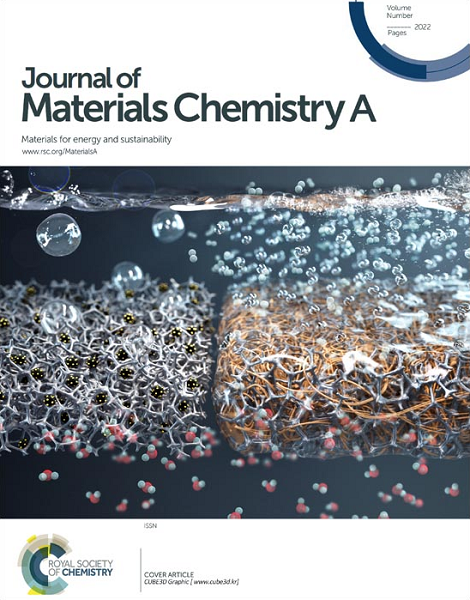一种一维无铅杂化钙钛矿,用于稳定的x射线检测,检测限低
IF 9.5
2区 材料科学
Q1 CHEMISTRY, PHYSICAL
引用次数: 0
摘要
卤化铅钙钛矿由于其优异的光电性质,在x射线直接探测中获得了超高的灵敏度。然而,铅的毒性引起了大量的环境和生物安全问题,这促使人们深入探索生态友好的无铅替代品。在这里,我们报道了一种新的一维氯化铋钙钛矿(PPA)2BiCl5 (1, PPA = r- 1-苯丙胺),具有由角共享[BiCl6]3-八面体组成的之字形无机链。这些无机链被有机芳香族配体通过强大而丰富的氢键稳定,从而赋予1优越的结构稳定性和抑制离子迁移的能力。基于高质量单晶制备的直接x射线探测器的检测限为175.3 μGy - s-1,比常规医学成像所需的检测限(5.5 μGy - s-1)低约30倍。此外,它还显示出7.67×10-7 nA cm-1 s-1 V-1的超低基线漂移,即使在高通量x射线照射和大偏置电压(100 V)下也具有出色的长期工作稳定性。这项工作构建了一种全新的无铅钙钛矿,可以实现低剂量率、长期稳定运行的绿色x射线检测。本文章由计算机程序翻译,如有差异,请以英文原文为准。
A one-dimensional lead-free hybrid perovskite for stable X-ray detection with low detection limit
Lead halide perovskites have achieved ultrahigh sensitivity in direct X-ray detection owing to their excellent photoelectric properties. However, the toxicity of lead raises substantial environmental and biosafety concerns, which motivates intensive explorations on eco-friendly, lead-free alternatives. Here, we report a novel one-dimensional bismuth chloride perovskite, (PPA)2BiCl5 (1, PPA = R-1-phenylpropylamine), featuring zigzag inorganic chains composed of corner-sharing [BiCl6]3- octahedra. These inorganic chains are stabilized by organic aromatic ligands via strong and abundant hydrogen bonds, hence endowing 1 with superior structural stability and the capability of suppressing ion migration. Fabricating a direct X-ray detector based on high-quality single crystals of 1 exhibits a low detection limit of 175.3 nGy s-1, which is approximately 30-fold lower than that required for regular medical imaging (5.5 μGy s-1). Furthermore, it also shows an ultralow baseline drift of 7.67×10-7 nA cm-1 s-1 V-1 as well as excellent long-term working stability even under high-flux X-ray irradiation and large bias voltage (100 V). This work constructs a brand-new lead-free perovskite that enables low dose rate, green X-ray detection with long-term operational stability.
求助全文
通过发布文献求助,成功后即可免费获取论文全文。
去求助
来源期刊

Journal of Materials Chemistry A
CHEMISTRY, PHYSICAL-ENERGY & FUELS
CiteScore
19.50
自引率
5.00%
发文量
1892
审稿时长
1.5 months
期刊介绍:
The Journal of Materials Chemistry A, B & C covers a wide range of high-quality studies in the field of materials chemistry, with each section focusing on specific applications of the materials studied. Journal of Materials Chemistry A emphasizes applications in energy and sustainability, including topics such as artificial photosynthesis, batteries, and fuel cells. Journal of Materials Chemistry B focuses on applications in biology and medicine, while Journal of Materials Chemistry C covers applications in optical, magnetic, and electronic devices. Example topic areas within the scope of Journal of Materials Chemistry A include catalysis, green/sustainable materials, sensors, and water treatment, among others.
 求助内容:
求助内容: 应助结果提醒方式:
应助结果提醒方式:


